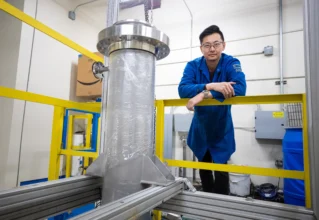Tip-top tanks
Features
Modern technology makes remote automatic
tank-gauging a viable storage option
By Bill Pierce
Manual gauging operations, especially on large, remote tanks, has always been a challenge for operators. Weather factors, including snow and ice on ladders, stairways and tank tops, make the job even more difficult and dangerous, especially in snowy regions like the Northeastern United States and Canada.
However, fuel oil marketers everywhere are discovering the benefits of better automation, safety, and the accuracy and dependability that have become available recently through advanced technology in level sensors and instruments. These systems are now available to most bulkplant operators. No longer used just by large refineries, these modern technologies are increasing profit margin through better inventory management. And, of course, safer and better use of personnel is a key feature of modem systems.
Rollie Technical Systems of Winchendon, Mass., has been designing and manufacturing modem accessed liquid level sensors and controls for the fuel oil market. The Rollie products include sensors and systems for small residential tanks up to large multi-tank installations. Jowa Consilium US, Inc. of Littleton, Mass., has been an industry leader in tall-tank electronic level gauging for almost 40 years and has a proven track record in thousands of installations worldwide in marine, chemical, petrochemical and water applications. Jowa recently acquired the complete Rollie product line to complement its line of tall-tank level sensors. The product line includes the Rollie MC2200, a multi-channel level gauging system with dialup and Internet access. The MC2200 was used on a recent project at Springfield Terminal, Inc. of Springfield, Mass.
Noonan Energy, the owner of Springfield Terminal, Inc., recently decided to install automatic tank gauging on one of its tanks, a 50-foot-tall throughput tank that receives its oil via pipeline system. The tank location was remote from the main office area, which meant that whenever a reading was needed someone had to drive to the site, climb 65 steps to the top of the tank and make a manual tape reading. The obvious solution was to have a system that would monitor the tank level 24/7 and make that data available at the office without the need for someone to visit the site.
Joe Pauk, owner of BWG Specialized Products, Oxford, Mass., and the regional field representative for Jowa Consilium, brought Jowa engineers to Springfield Terminals locations to determine the best solution. Their requirements were that the system be accurate, reliable and not take the tank out of service during installation.
Jowa manufactures a level sensor based on a technology called resistance tape. This technology features no moving parts and, unlike a tape-and-float system, this tape has no markings, has no moving parts to stick or seize up, and has an electrical output representing the liquid level. The sensor is a flexible circuit built on a stainless steel strip of steel. A resistive element is wound around the steel strip in such a way that it produces a resistive output proportional to liquid level. The inner element is protected from the product to be gauged by a flexible barrier made of Hastelloy steel, an exceptionally strong and corrosion-resistant alloy. The Petrotape level sensor is constructed using the basic resistance tape technology with a Hastelloy outer layer and other materials suitable for use in petroleum products, including gasoline.
For STI, Jowa Engineers specified the Rollie MC2200 Tank Gauging System with modem dialup capability. This system includes 22-tank input capability, local display of level, volume and alarms, and either dial-in or Internet-based data retrieval. The system was configured with a 50-foot Petrotape level sensor, MC2200 processor and display, and a dialup modem. Installation of the sensor is a simple operation requiring only a three-inch NPT-threaded pipe at the tank top. Tank entry is not necessary and no other tank modifications are needed. The sensor is inserted through the pipe at the top of the tank. Operations personnel are now able to dial the unit directly from any PC with a modem and are able to retrieve the tank level and volume in real-time.
According to the owners at STI, other electronic systems were tried in the past with poor results so they were a little skeptical about installing a new system on a large number of tanks without knowing how well it would work. STI’s requirements were that the system be accurate, reliable and not take the tank out of service during installation. Using the Petrotape level sensor and MC2200, Jowa was able to meet all of their requirements.
The sensor can be made from three to 100 feet long and is shipped rolled up on a three-foot diameter reel. A one-foot length of three-inch pipe installed at the tank top was the only modification to the tank. The level sensor is unreeled into the pipe and secured with a simple slip nut inside the provided stainless-steel housing. A long, stainless-steel weight at the bottom of the sensor keeps it from moving around in the tank during filling operations.
The owners are pleased with the performance of the sensor and system. A recent check revealed the systems reported level reading was within 1/8-inch of a manual tape reading. The Rollie system has been used successfully on numerous other area projects and now includes the ability to provide long sensors for tall tanks, and wireless battery-operated radio transmitters can be used when the cost of electrical wiring or the lack of power is a problem. Jowa Consilium offers expert installation and pre-sales consulting services and has over 40 years in the level-gauging business worldwide.
Bill Pierce is a product manager for Jowa Consilium and can be reached at (978) 486-9800. Joe Pauk, owner of BWG Specialized Products, can be reached at (508) 527-3679.

